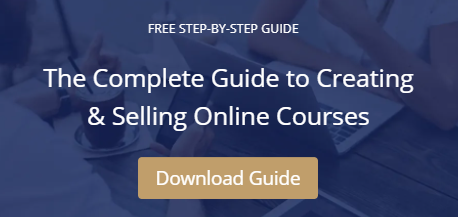“What if my course bombs?”
The excitement you felt for your online course has turned into a litany of what-ifs:
What if nobody buys it?
What if my students hate it?
What if I suck?
You’ve done your due diligence. You know your online course idea will meet a need and fulfill a desire that matters to your market. You’re confident in your ability to teach them something that will change their lives.
But still, you wonder… what if you’re wrong?
Unless you want to be another frustrated, disillusioned online course creator, there’s a better way to move forward with your course idea… one that guarantees people want it, will pay for it, and will benefit from it.
Educators who skip this step find themselves wasting hundreds of hours of work on a course that few people want or doesn’t deliver the promised results. All because they assumed they knew what the market wanted. They thought they knew the best way to deliver the content. And they assumed wrong.
There’s a better way to test your course idea in the real world. And even get paid while you’re at it.
It’s called piloting.
You know how TV producers pilot their shows? They assemble the cast and crew and produce the first few episodes. They promote the show and air it. Then, depending on how viewers respond, they decide whether to continue the series or not.
That’s what you’ll be doing with your pilot course. You’ll plan and sell a small portion of your full online course and see how your target market responds. From there, you can decide to either move forward with the full course or to pivot to a different course altogether. Either way, you’ll be armed with the insights you gained from your pilot students.
And you wouldn’t have spent all your time and energy on a failed experiment 🙂
So how do you test your course idea in the real world?
This post will walk you through the steps.
Step 1: Determine your minimum viable outcome
Your pilot course is a scaled-down version of the full course you have in mind. It must be small enough in scope that you can implement it within six weeks or so. But not so small that it doesn’t deliver appreciable results to your students. To find that sweet spot, you must determine the minimum viable outcome for your pilot course.
Start by thinking big. If you had a magic wand, what outcome would your students want you to create for them? (Credit for this magic wand technique goes to BJ Fogg.)
In all likelihood, this outcome is something so outlandish that you or anyone else couldn’t possibly deliver it. For example, if you’re considering a course about weight loss, the answer might be, “My students want to lose their excess weight, burn fat, and build lean muscle in seven days.”
It’s a wonderful outcome, but also unrealistic.
Since you don’t have a magic wand, you can’t deliver this ultimate outcome. But you can deliver something close enough. Ask yourself, “What’s the next best thing I could provide?” Keep asking this question, until you have a result you can deliver within three to six weeks—the typical duration of a pilot course.
In this case, it could be: “At the end of four weeks, my students will learn how to manage their cravings for sweets and other unhealthy foods.”
That’s the minimum viable outcome of your pilot course! Once you have a clear, focused, and market-validated promise, then you can move on to planning your pilot course.
Step 2: Choose your pilot type and price
Decide whether you want your pilot course to be high-touch or low-touch. Each has its pros and cons.
A high-touch course requires you to spend more one-on-one time with each student. For this reason, it will take up more of your time and energy. But at the same time, you’ll be able to get more in-depth feedback and insights from your beta students, which would be valuable in developing your full course. You’ll also be able to charge more for the pilot course.
Examples of high-touch courses include individual coaching, small group coaching and training, or a hybrid of the two.
Low-touch courses allow you to reach more students with one effort. You’ll have to charge less for the pilot course, but you’ll be able to accept more students.
Low-touch options include live boot camps, large group coaching, and email training.
How Much Will You Charge?
You’ll also need to decide how much to charge for your pilot course. Start with how much you plan to charge for the full course, then adjust relative to the amount of content and outcomes in the pilot vs. the full course, and the relative amount of individual attention and support you’ll provide.
Let’s say you want to charge $997 for the full course, and the pilot will be a low-touch course with 20% of the final course content. A reasonable price for the pilot would be $197. On the other hand, imagine your full course will be $4,997, and the pilot will be high-touch and will provide 25% of the full course content. A possible price for your pilot could be $1,497.
Whatever number you arrive at, validate it against your financial goals and target market. Each market is different and will have a different threshold.
Related: How to Price Your Online Course (Complete Guide)
Step 3: Plan your pilot curriculum
Now you’re ready to plan your pilot curriculum. I guarantee you’ll have it ready within a couple of hours. In fact, your pilot plan won’t take up more than a page of letter-sized paper.
Keep your pilot plan short and simple, because you want to give yourself plenty of room to maneuver as you respond to feedback from your students. Leave most of the curriculum development work until after you’ve sold the pilot.
Right now, you need only the broad strokes of what you’re going to teach, how long the pilot will last, and what the experience for the student will be like—just enough details for you to sell the pilot course.
The first step is to define the start and end points of your students. Point A is the problem or challenge they’re currently experiencing and want to solve. Point B is the minimum viable outcome or promise of your pilot.
Think about the things your students need to learn to achieve success, to go from Point A to Point B. The big concepts or steps you’ll cover in one shot are the lessons. Each lesson should build on the prior skills and knowledge of your students, to scaffold them, so to speak, to the next step.
Under each lesson, make a bulleted list of sub-topics you’ll cover. It doesn’t have to be too detailed, just enough so it’s clear to you and your prospective students exactly what the pilot course will cover.
Keep in mind: give your students only what they absolutely need to achieve the minimum viable outcome your pilot promises. It’s not to be stingy; it’s to be judicious and avoid anything that might distract or divert your students from the desired outcome.
Also, remember that you want to deliver the pilot within six weeks, at the most. This is brief enough that your students will stay motivated, engaged, and available to give the feedback you need. But at the same time, it’s long enough to achieve an outcome they care about.
You also want to complete your pilot as quickly as possible, so you can learn and iterate rapidly towards your full-scale product.
When you have your one-page pilot plan, fill in the actual dates for each of the lessons. The first lesson should begin within a week of the last day of your launch.
Mode of delivery
Now that you know the content of your pilot course, it’s time to think of how you’re going to actually deliver the lessons.
Your mode of delivery should be as simple and low-tech as possible, considering the requirements of your topic. Avoid having to learn new technologies, and minimize the use of new or unfamiliar technology.
In other words, don’t use Skype if the phone will do. Don’t use GoToWebinar if Google Hangouts will serve just fine.
Step 4: Sell your pilot
You’ve got your pilot course all planned. Now it’s time to sell it!
Here’s the basic process for selling your pilot course:
1. Float the idea of your pilot to people who may want it
Announce that you have something in the works, and tell the story of how you came up with the idea. Use email, a blog post, or whatever medium you normally use to connect with your audience (And if you don’t a list of email subscribers, you still have an audience by way of your personal, professional, and social media connections).
You’ll also want to get people excited about your pilot course, by engaging them in some way. Ask for feedback on your pilot idea through a phone call or online survey, for example. If you already have an audience of 500 subscribers or more, and are comfortable with the technology, you can give them a taste of your pilot through a webinar.
While you’re building excitement and anticipation for your pilot course, you can also get your audience’s inputs on what type of a pilot course would really help them.
2. Make your offer
With your audience primed, it’s time to open the curtains on your pilot course. Focus on the problem it will solve, and what outcomes it will create. Describe what the experience will be like, so your audience can imagine themselves as your students. And paint a picture of what their outcomes will be.
Don’t forget to put a cap on the number of students you will accept. Because this is a pilot, you want to keep the class size manageable while you’re still figuring out the best ways to refine your course.
When you make your offer, remind your audience of the number of students you’re taking and the deadline to register. This gives your offer urgency, which can help people take action and buy, instead of putting it off.
3. Close the sale
Collect their payment and give them a spot on your pilot course. If you’re on the phone with them, offer to get their payment details so you can process the payment through PayPal (or whatever payment processor you use). Or, if you made your offer in an email or webinar, send them to either a checkout link or sales page to process their registration.
That’s all there is to it.
But while the general idea is the same, the execution will be different depending on the size of your existing audience or network.
If you don’t have an email list, you could accomplish the first step through email, and the second and third steps through a single phone conversation with each of your prospects. If you have a bigger audience and are comfortable with the technologies involved, your pilot course launch could involve a series of emails, blog posts, and other media, ultimately leading to your course sales page.
Step 5: Proceed or Pivot
If you enrolled as many students as you hoped for, then congratulations! You can proceed with delivering your pilot course.
But if you’ve followed these steps and didn’t fill your pilot course, you need to go back to your notes and ask yourself: Is there really a demand for the course? Is the pricing wrong? Do your prospects like the topic but not the mode of delivery? Did you misunderstand the outcomes that they care about?
Now’s the time to pivot and adjust your plans. It’s very disappointing to be in this situation, but it’s much better to cut your losses now than to invest the time, energy, and money developing a full-blown course that doesn’t sell.
You may have to go back to researching your audience’s pains, problems, and frustrations. And then follow the steps again, from nailing down a minimum viable outcome, to planning and selling your pilot course.
Eventually, you’ll have a successful pilot course.
You’ll have real-life validation that there’s a demand for your course. People do pay for it. They like your content and the way you deliver it. And they’re actually getting good results.
That’s when you know you have a potential winner on your hands. Then you can put your worries to rest and get excited about your course again.
5 Steps To Test Your Online Course Idea In The Real World @DannyIny Click To Tweet
Danny Iny is the founder and CEO of Mirasee, host of the Business Reimagined podcast, and best-selling author of multiple books, including Teach and Grow Rich: The Emerging Opportunity for Global Impact, Freedom, and Wealth.







